Book depositories: NLB makes concerted effort to spruce up libraries
In the past year, the National Library Board has revamped and reopened five libraries in malls and town hubs, creating bigger and niftier spaces for users
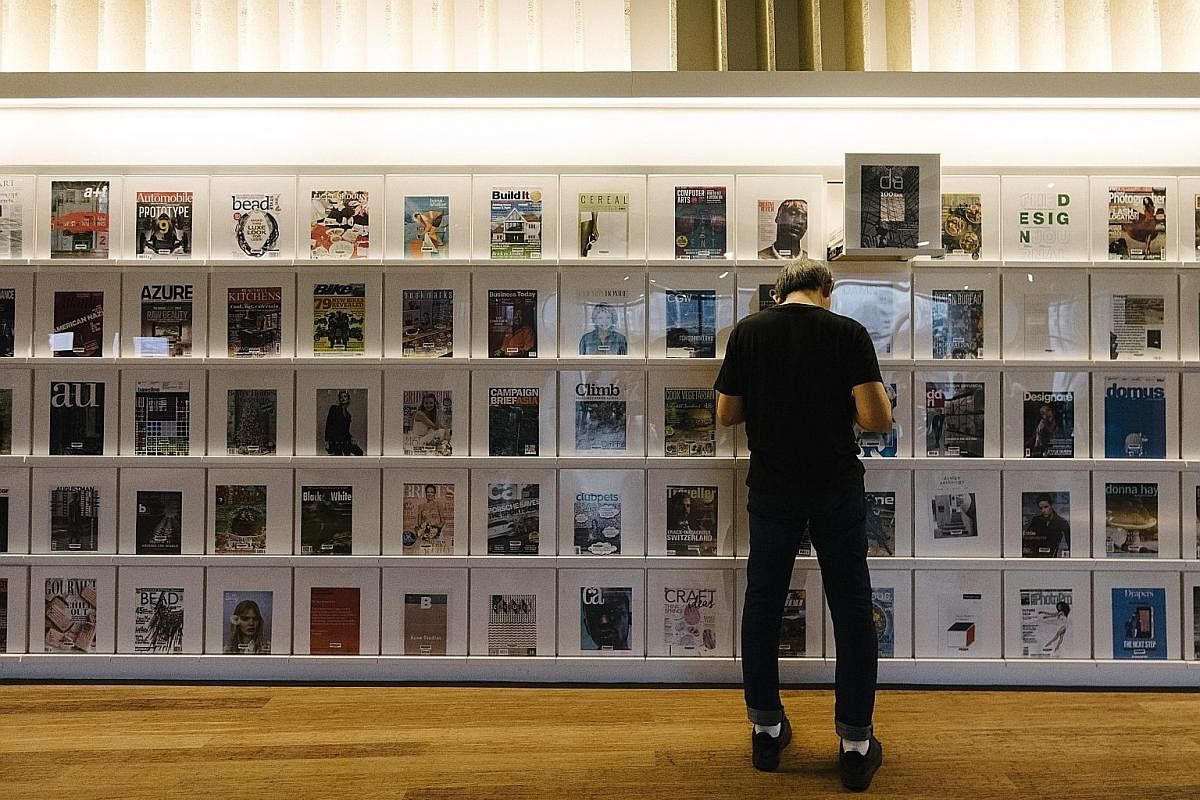
ST PHOTO: ALVIN HO
Shop until you book drop, as more libraries are spruced up and moved into malls, with the National Library Board (NLB) making a concerted effort to plant its branches where footfall is highest.
In the past 12 months, it has revamped and reopened five libraries in malls and town hubs: Sengkang, Bukit Panjang, Tampines, Bedok and, last week, Yishun.
At the end of the year, Bukit Merah Public Library will move from Bukit Merah Central to VivoCity mall, where it will take over the space now occupied by Japanese retailer Daiso. At 3,000 sq m, it will be the largest mall library to date.
Minister for Communications and Information Yaacob Ibrahim wants libraries to "continue to explore locations that can bring traffic in".
Speaking at the re-opening of Yishun Public Library at Northpoint City mall earlier this month, he said: "Locating (a library) in a mall allows Singaporeans of all ages to come. While they're shopping, they can drop by; after their library visit, they can do other things."
For the newly revamped libraries, visitorship figures show higher footfall. Sengkang, Bukit Panjang, Tampines and Bedok all saw an increase in the average number of visitors a month, from 28 per cent for Bedok Public Library - which reopened in October last year - to more than double for Bukit Panjang Public Library, which went from 55,000 a month to 120,000, and Tampines Regional Library, which went from 76,000 to 170,000.
This is the fourth wave of library growth in Singapore, according to NLB assistant chief executive of public libraries Catherine Lau.
The first wave in the 1970s involved setting up libraries, largely in standalone buildings within new towns, due to the rapid growth of population in these areas.
In the next wave in the 1990s, NLB began putting libraries into malls - mostly heartland ones, starting with Jurong West Community Library in Jurong Point in 1996 - while the third wave in the 2000s was marked by "co-location", in which libraries were placed alongside other facilities such as community centres.
Today, half of the 26 public libraries in Singapore are in malls. Five, including the recently opened Tampines and Bedok, are in integrated hubs with other amenities such as sports centres, polyclinics and retailers.
The recent push comes as book readership finds itself under threat in Singapore. In an NLB survey last year on reading habits, just two in 10 adult Singaporeans said their weekly reading included books, whether print or e-books.
Ms Lau says: "People feel they don't have time to read or go to the library. We need to be convenient for them. Whether a library is one or two blocks away from the MRT station makes a difference."
The presence of a library in a mall can sway people such as Mr Samuel Lee, who works in corporate lending. On his own, the 36-year-old would visit a library perhaps once a year. But if there is one where he is already meeting friends, such as library@ orchard in Orchardgateway, he feels more inclined to drop in.
"It's central and convenient," he says. "I think I'll be back."
Spaces in malls are smaller than in standalone buildings, says Ms Lau, and fitting reams of books into them requires much manoeuvring.
For Bukit Panjang, for instance, the library had to be split into two halves at either end of the mall's atrium, which confused visitors at first. This did, however, enable the library to segregate the children's wing, which tends to be noisier, from the adults', where people prefer to do quiet reading.
A small library takes a year to plan, while bigger regional libraries take a few years.
From transparent book drops that allow the public to watch the AutoSorter - a machine which sorts returned books for easy re-shelving - to simple ergonomics such as the angling of lower bookshelves upwards to minimise neck strain while browsing, Ms Lau says a lot more thought goes into library design compared with 30 years ago.
Users such as Tanjong Pagar resident Wu Shu Li, 41, are looking forward to having a library in VivoCity.
"It is much more convenient," says the housewife.
But not all are happy with the move. When it was announced, Mr Alexander Yap Yuk Ken and Mr Chen Junyi wrote in letters to The Straits Times Forum page that VivoCity is a "tourist mall", unlike Bukit Merah Central, which is surrounded by residential estates and schools, and that the current library's user base of students and the elderly would be left behind.
Ms Lau argues that compared with Bukit Merah Central, where visitorship has been falling, footfall at VivoCity is "very, very high".
But she acknowledges that some people remain disinclined to make the trip out to Harbourfront. So the NLB has set up nine reading corners in community centres and residents' committees around Bukit Merah, where book collections of 500 to 2,000 books will be refreshed every quarter.
And not all readers find the new libraries welcoming. Bedok Public Library, for instance, has a zone dedicated to seniors, with a large print collection and an electronic magnifier. But some still yearn for the smaller library of yore.
"This library has better facilities," says retired Chinese tutor Ong Chee Kiong in Mandarin. The 64-year-old visits four times a week. "But it does feel less friendly - the librarians are so spaced out, you can't really see them."
Retired interior designer David Law, who is in his 60s, says: "One has to be selective about putting libraries in malls. Will they have the breadth of books to satisfy everyone?
"But when it is done well, such as library@orchard, then people will come."
After Bukit Merah, the next library on the horizon is the Punggol Regional Library, a new branch slated for 2021.
Ms Lau says: "The libraries of the future will be more customised, make more use of technology and digital offerings, but not lose sight of physical touchpoints.
"They will be nicer spaces for everybody."
Library@Chinatown
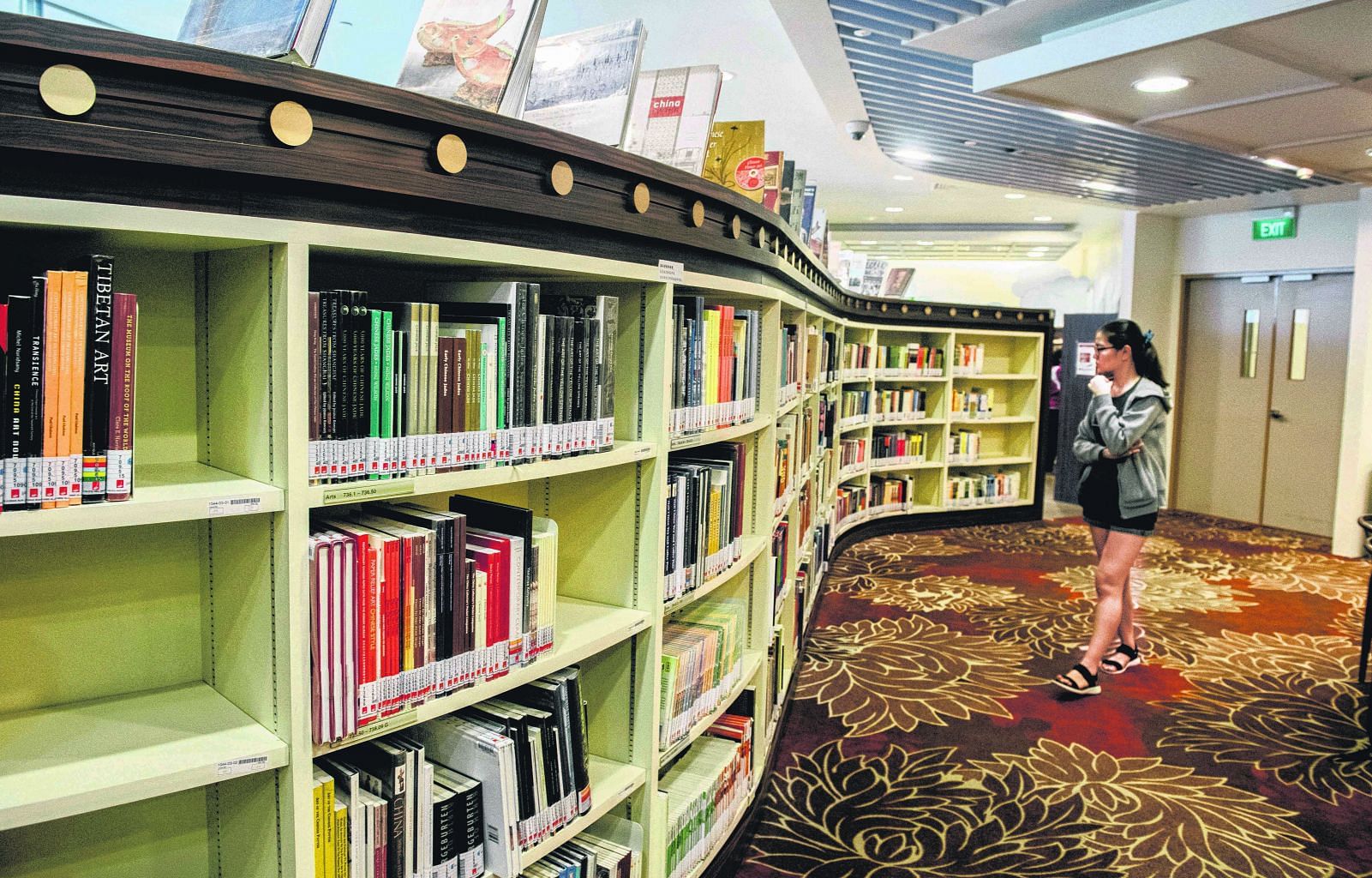
Where: Chinatown Point, 04-12, 133 New Bridge Road Area: 1,000 sq mOpened: 2013
With its lattice screens and rich red-and-gold carpet, this library looks a little like an old-school Chinese restaurant - not out of place for an establishment in the heart of Chinatown.
No surprise, then, that its focus is on Chinese arts and culture, with 65 per cent of its collection in Chinese.
The library is popular with seniors living in the area. On a weekday afternoon, they can be found browsing the papers in armchairs or simply people-watching in various degrees of repose.
Lawyer George John, 67, who works nearby, likes to spend about 45 minutes relaxing in the library on his lunch break.
While he does not read Chinese, hanging out there got him interested in travel books on China, so much so that he recently went on a trip to Nanjing.
"A library is important to the identity of a community," he says. "Somewhere for people to just sit and read."
Many of those who enjoy spending time in the library have since gone on to give back to it. The first entirely volunteer-run public library in Singapore, it has gone from more than 20 volunteers when it opened to 120 last year.
Madam Chow Wai Ling, 70, remembers learning the ropes as a volunteer when all the shelves were still empty. Now that they are full of titles that range from calligraphy to cookbooks, she feels a sense of ownership.
"When I put back the books people have pulled out, it is kind of like tidying my house," the part-time childcare assistant says in Mandarin. She volunteers twice a week from 2pm until the evening, during which she re-shelves two trolleys of books.
"I always liked to read, not so much to talk. So this is perfect for me."
library@orchard
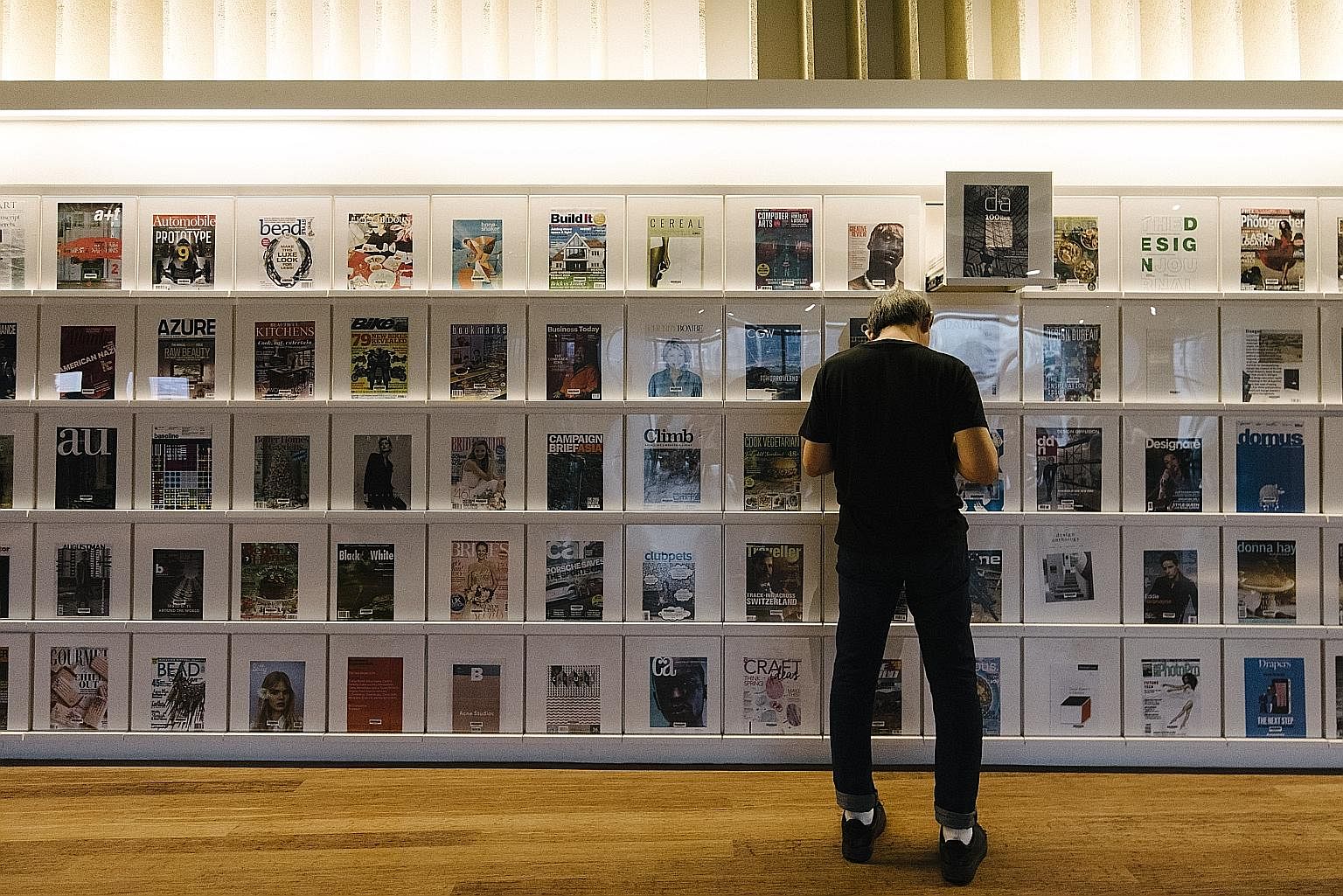
Where: Orchardgateway, 03-12/04-11, 277 Orchard Road Area: 1,700 sq mOpened: 1999, 2014
With its sleek curves and sliding ladders, library@orchard is arguably the most Instagrammable library in Singapore.
The library's focus is on design and this is apparent not just in its contents - it has the largest selection of design magazines among the public libraries - but in the clean lines of its architecture.
Readers can gather at the timber steps amid the waves emerging from the spines of books and DVDs, or squirrel themselves away in the cocoon-like nooks at the ends of bookshelves.
It has won a number of accolades, from the President's Design Award in 2015 to the American Library Association's Presidential Citation for Innovative International Library Projects in 2016.
It was the first library on the major retail belt of Orchard Road when it opened at Ngee Ann City in 1999.
It shuttered at that location in 2007 when its lease was not renewed, but was revived in its new form when Orchardgateway opened in 2014.
Copywriter Jaisree Soule, 34, moved to Chicago two years ago, but remains so fond of library@orchard that she makes it a point to visit whenever she is in town.
"It's modern and has a wide selection of books," she says. "If more libraries move into malls, there may be space constraints that prevent them from housing more books, but if they follow this look and feel, I think it is fine."
Pharmacist Rison Yeong, 50, visits once a month, drawn by the library's collection of art magazines.
"I like the architecture, the ambience, the way the books are displayed.
"The area where people can sit and do work by the windows is good for inspiration."
Bedok Public Library
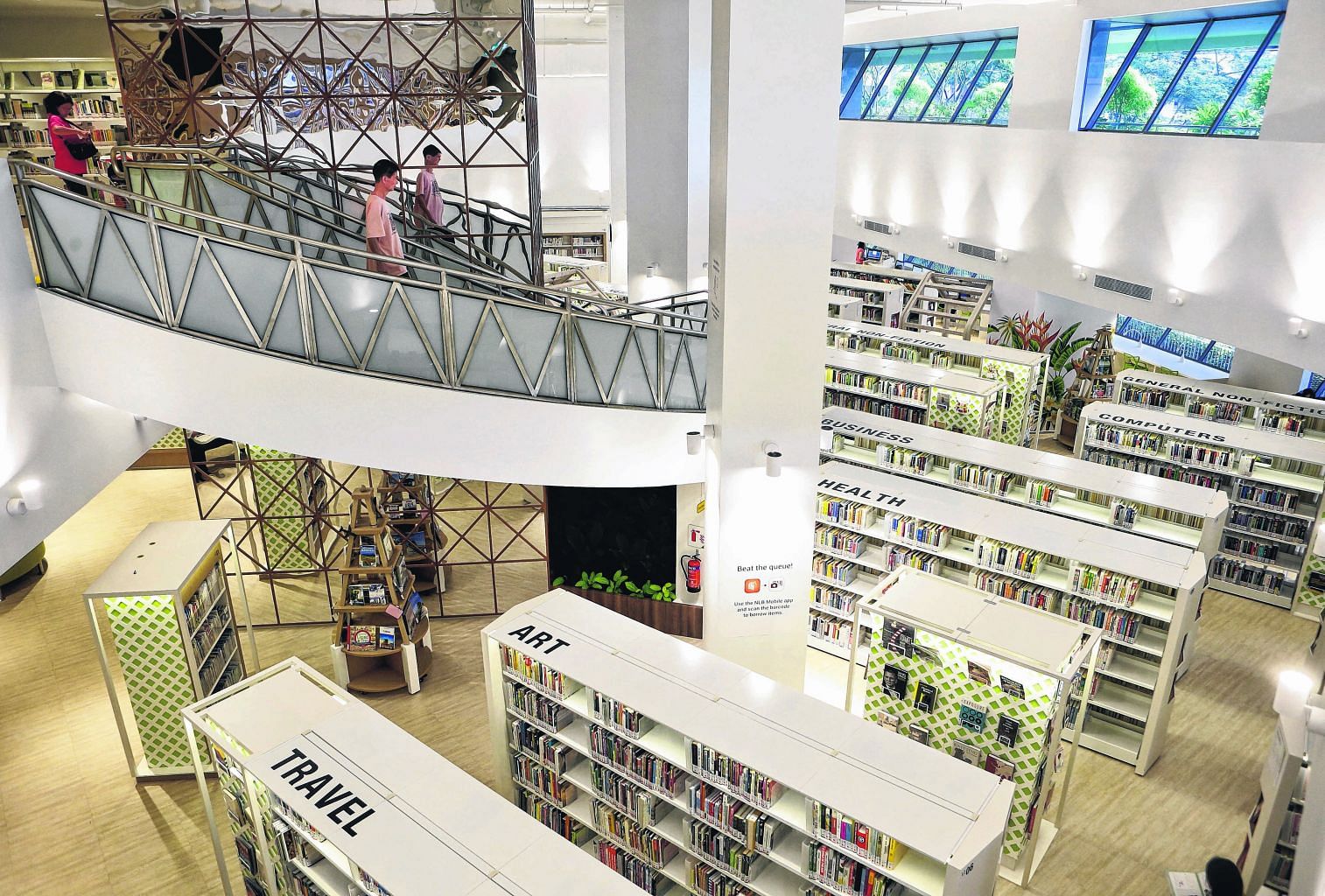
Where: Heartbeat@Bedok, 02-03/03-04, 11 Bedok North Street 1 Area: 4,150 sq mOpened: 1985, 2017
"If you have a garden and a library," wrote the Roman statesman Cicero, "you have everything you need."
Such, perhaps, was the thinking behind the revamped Bedok Public Library, which, after more than 30 years, moved in October last year to Heartbeat@Bedok, Singapore's second integrated community hub, alongside facilities such as a sports centre, polyclinic and more than 30 retailers.
Leaf-green tones and floral patterns adorn the two-storey library, where bookshelves seem to grow upwards in organic curves to become part of a wooden canopy. In the children's section, large snails laden with books surround a giant watering can.
Residents, particularly parents, say the new library is more spacious.
"It used to be a normal, small library," says housewife Rin Azhar, 34, a mother of five. "This one is bigger and better and they made it like a garden so it is nice to sit in."
The reading areas are dotted with small huts, in which students such as Nur Ain, Nur Syazwani and Angela Chin, all 12 and from Bedok Green Secondary School, curl up after school every day to do homework or read comics.
"It's a conducive environment to study," says Nur Syazwani.
"It's more spacious," says writer Clarissa Goenawan, 29, who used to study in the library. "Previously, you had to line up before the library opened and compete with the uncles to get a seat. Now I never have problems finding seats."
Yishun Public Library
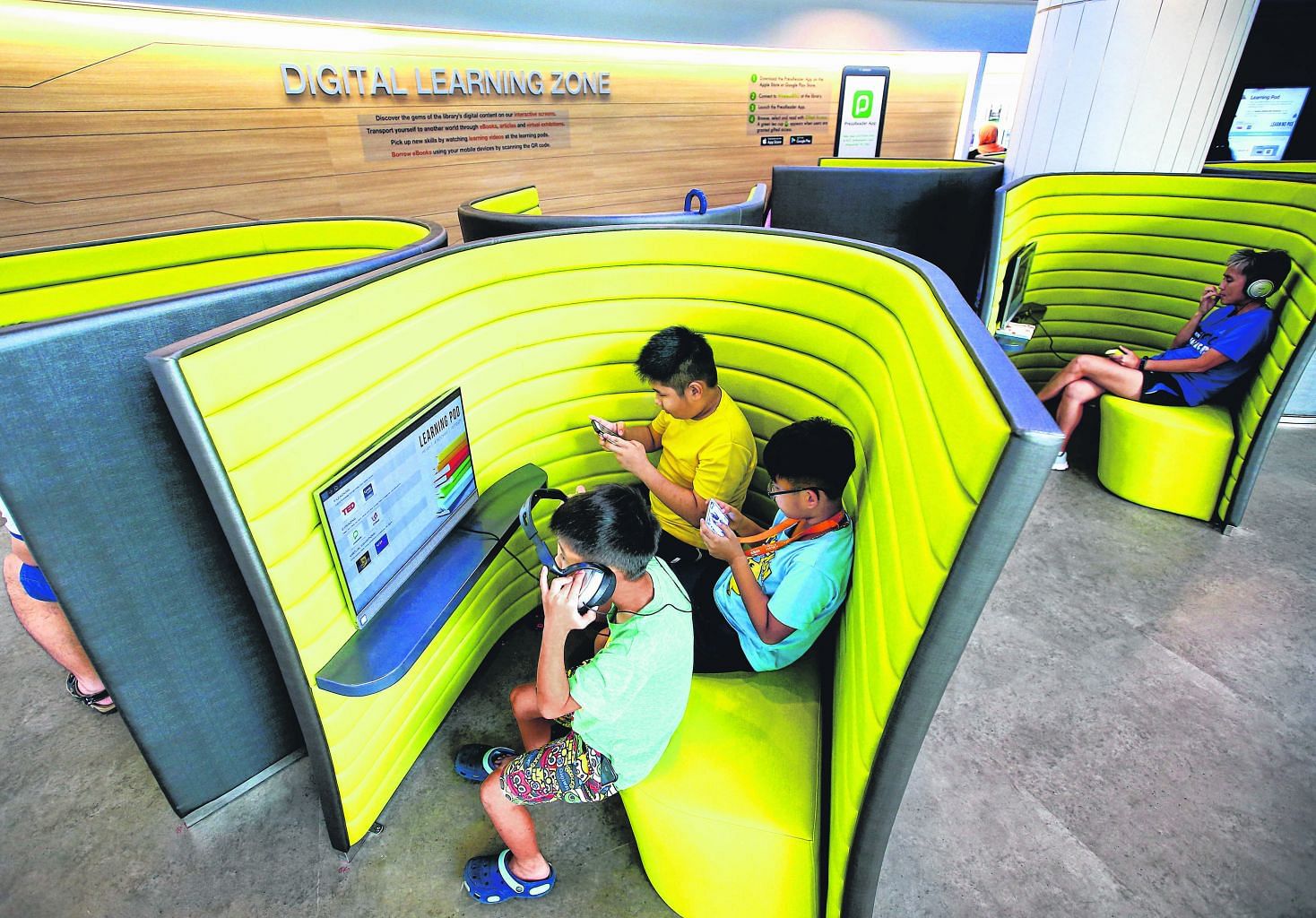
Where: Northpoint City, 04-01, North Wing, 930 Yishun Avenue 2 Area: 2,530 sq m Opened: 1998, 2008, 2018
At Yishun Public Library, which re-opened its doors a week ago after a revamp, people are just as likely to be swiping screens as turning pages.
The library's heart is its digital learning zone, the first in the public library network.
Mounted on its walls are 12 screens, from press readers that allow users to browse magazines from all over the world online, to virtual bookshelves from which they can borrow books simply by scanning QR codes.
In a long animated display with the theme of SkillsFuture, the nationwide drive towards lifelong learning, the covers of business and self-improvement books spiral slowly across the screen to ambient music.
Physical books continue to form more than 90 per cent of loans at public libraries here, says National Library Board assistant chief executive of public libraries Catherine Lau, although e-book borrowing rates have been increasing quickly over the past few years.
"We are indifferent to whether people are reading in physical or e-book format," she adds. "We just want to promote the entire reading pie."
The zone also has seven learning pods, each equipped with an interactive screen through which users can access resources such as courses from e-learning platform LyndaLibrary and videos from Ted talks.
"It's very fun and interactive," says software developer Ivan Aung Hein, 40, as his family swipe their way through a virtual bookshelf. "It makes browsing books and magazines a lot easier."
The library opened in 1998 above Sembawang Town Council, then re-located in 2008 to Northpoint Shopping Centre, which was later absorbed into Northpoint City.
"There's a lot of new e-learning inside and I am excited about this new technology," says retired secretary Elizabeth Tan, 56, who can spend an entire day in the library reading.
She missed it, she says, when it was under renovation and had to go to Sembawang Public Library for her reading fix.
"I'm very happy to be back here. It's almost like being home."
Correction note: This story has been edited for clarity.
Join ST's Telegram channel and get the latest breaking news delivered to you.
A version of this article appeared in the print edition of The Sunday Times on February 11, 2018, with the headline Book depositories: NLB makes concerted effort to spruce up libraries. Subscribe

